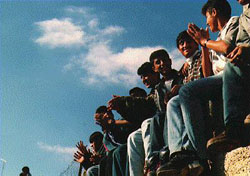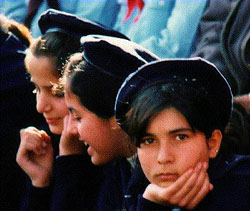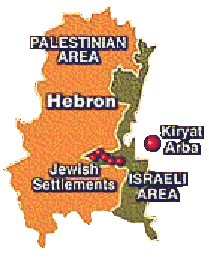
The atmosphere was very mixed. In Ramallah after the December 1995 redeployment, everyone celebrated. In Hebron it was mixed. At a celebration rally in a school on 18 January, the feeling was very mixed.
The Hebron deal was not the best it could have been with the continued presence of extremist Jewish settlers in the middle of the town, and now people had more of an idea how the Palestinian Authority would run their city after a year's testing in Ramallah and other West Bank towns.

This girl scout summed it up for me, with her clear, straight gaze into the lens. Not phased by all of the razamataz, she was the face of Hebron's future. The celebrations mean nothing if they do not guarantee a secure future. Netanyahu's election phrase, "Peace with security" begs the question, "Whose security?" At the moment it is very clear exactly how much one can expect from the final status talks on settlements.
If the 400 settlers in the midst of Hebron cannot be moved 1 km down the road to Kiryat Arba, it doesn't look too good for the Palestinian population that wants Kiryat Arba to eventually go.
Adli is one of those people. His family and his wife's family have had the remainder of their land confiscated by the Kiryat Arba settlement just in the last few months.

Of course, the checkpoints and new borders of Hebron represent the first time the city has been divided. Jerusalem, which is very clearly defined into Jewish and Arab areas, may also be eventually divided in the final status talks.
Jerusalem has nothing like this though, a small spearhead of settlements intruding right into the most populated area of Hebron, the city center.
The immense size of Hebron is apparent as you drive around it. It feels like a whole different Arab country when compared with Ramallah, for example. The fertile land and tombs of the Jewish Patriarchs attracted settlers here.
Their insistence that the land is theirs, because Abraham purchased it several millenium ago for a few shekels, is comic in the face of this huge metropolis where the Palestinian shoe factories can supply the whole Middle East if run at full capacity.

"Arab houses: Too close for comfort" reads the caption on this photo (right) from the Possible Dangers of Redeployment page of Virtual Jerusalem's Hebron website.
There is lots more about this website that would be worth commenting but I'll let you look for yourself. One wonders at the logic of the currently 400 Jewish residents, who moved into the middle of this area in 1968, and complain about their 120,000 neighbours.
Thankfully, the Israeli government is not crazed enough to consider trying to clear the area around the settlement of Arab homes, which the twisted thought above certainly has flirted with. As Jibril Rajoub said at the rally I was at, "They are a stone on our chests."
Netanyahu later freaked out about this statement but all it was, is a very accurate reflection of what the Palestinian population in Hebron feels like. Until the settlers leave, the Palestinians will never feel comfortable.
The coming year will be good for the Palestinians who want to be able to walk around most of Hebron with no danger of attack from settlers or IDF soldiers. But the new borders promise the conflict in this city will not pass away. They only make it clearer.